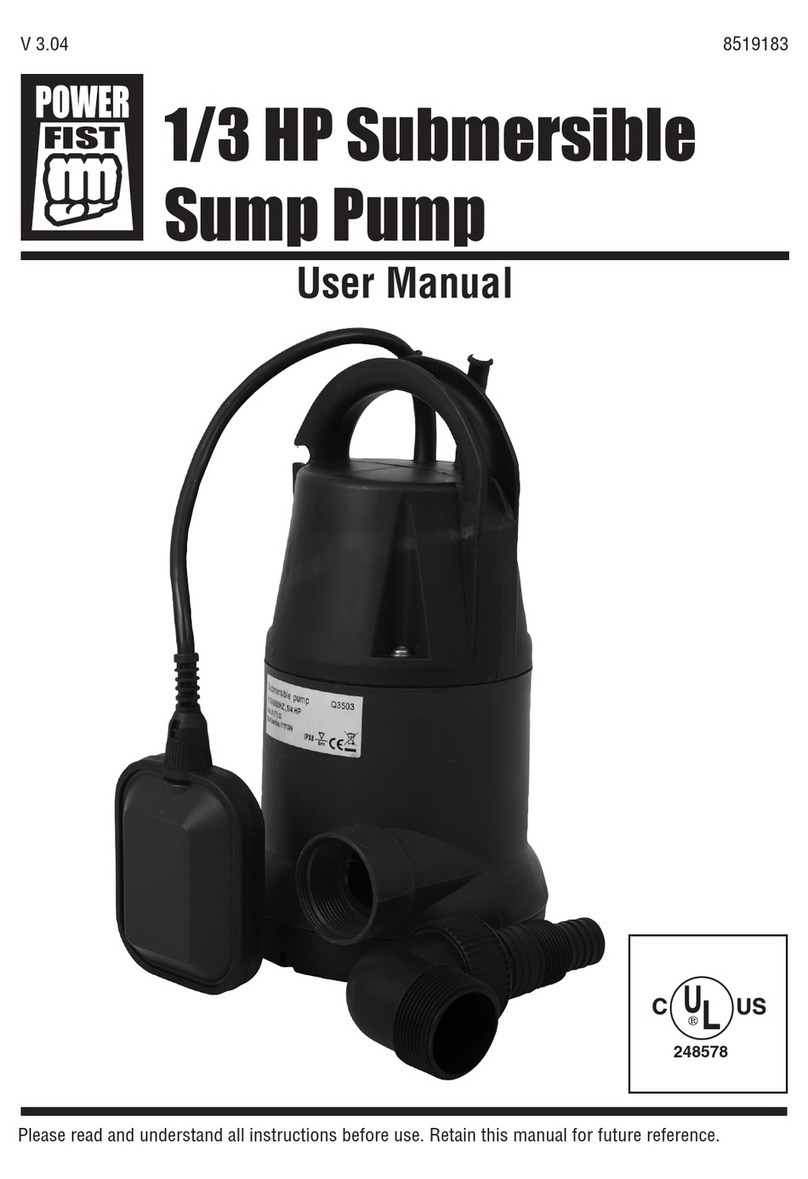Depa DL25-L User manual

1
DEPA®Air Operated Diaphragm Pumps
www.depapumps.com
www.cranecpe.com
Air Operated
Diaphragm Pumps
Operating and
Installation Instructions
Installation, Operation
and Maintenance
BA-DL-GB/01.19

2
DEPA®Air Operated Diaphragm Pumps
EC Declaration of Conformity
in compliance with the Machinery Directive 2006/42/EC
We hereby declare, that the pump units manufactured in series production
Designation: DEPA Air Operated Diaphragm Pumps
DEPA Active Pulsation Dampers
Series: DL, DH, DF, DZ, DP, DB
Manufacturer: Crane Process Flow Technologies GmbH
Heerdter Lohweg 63-71
40549 Düsseldorf, www.depapumps.com
Serial number: seeidenticationplate
in the version delivered by us, is in compliance with the following applicable regulations:
EC Directive: Machinery Directive 2006/42/EC
Harmonized standards: DIN EN 809:2012-10
DIN EN ISO 12100:2011-03
Mr. Ralf Rennwanz is authorized to compile the technical documents.
Crane Process Flow Technologies GmbH
Heerdter Lohweg 63-71
40549 Düsseldorf
Place, date Düsseldorf, 08/07/2015
Signature of manufacturer:
Information on signatory: Hans-Dieter Ptak, Managing Director
This is the translation of the original declaration of conformity
for DEPA Air Operated Diaphragm Pumps.
.

3
DEPA®Air Operated Diaphragm Pumps
for partly completed machinery
according to the machinery directive 2006/42/EC
The manufacturer Crane Process Flow Technologies GmbH,
Heerdter Lohweg 63-71, 40549 Düsseldorf, www.depapumps.com
declares that with the series production pulsation dampers
Designation: DEPA compressed air diaphragm pumps without air control
Series: DJ/DH*, PD, PH
* DHxx-FA in custom design with control block
for external air control.
Serial number: seeidenticationplate
thefollowingbasicrequirementsasspeciedinannexIoftheabovedirectivehavebeenappliedand
complied with:
General principles No. 1
Nr. 1.1, 1.3, 1.5, 1.6; 1.7, 2.1, 3.4, 3.6, 4.1 und 4.2
Commissioningisprohibiteduntilithasbeendeterminedthatthemachineintowhichtheabovespecied
machine shall be incorporated meets the machinery directive 2006/42/EC.
Pay attention to the installation instructions in Chapter 3 and 7.2 of these operating instructions.
ThespecialtechnicaldocumentswerepreparedincompliancewithannexVIIpartBofthedirective.The
previously mentioned special technical documents will be made available to the competent authority by
mail, if this should be necessary.
EC directive: Machinery directive 2006/42/EC
Harmonized standards: DIN EN ISO 12100:2011-03,
DIN EN 809:2012-10
Mr. Ralf Rennwanz is authorized to compile the technical documents.
Crane Process Flow Technologies GmbH
Heerdter Lohweg 63-71
40549 Düsseldorf
Place / date: Düsseldorf, 08/07/2015
Signature of manufacturer:
Information on signatory: Hans-Dieter Ptak, Managing Director
Declaration of Incorporation

4
DEPA®Air Operated Diaphragm Pumps
in accordance with directive 2014/34/EU for equipment intended for use
inpotentiallyexplosiveatmospheres
The manufacturer: Crane Process Flow Technologies GmbH, Heerdter Lohweg 63-
71, D-40549 Düsseldorf, www.depapumps.com
declares that the pump units manufactured in series production
Designation: DEPA Air Operated Diaphragm Pumps and
DEPA Active Pulsation Dampeners
Series: DL, DH, DF, DZ, DJ, DP, DBX* and PD, PH
* High pressure pump without booster
Assessment method: EquipmentgroupII,category2GD,explosiongroupIIBTx
Pump size: 15, 25, 40, 50, 80
Casing material: FA,CA,SA,SF-,SLV,SUV,UEV,CX,SX,PL,TL,SS,SFS,TPL,
HS, HX
Diaphragm materials: EPDM, FKM**, NBR, EPDM grey**, NRS, PTFE compound,
PTFE, S4**
** not for size 80
Valve ball materials: EPDM, NBR, PTFE, NRS, 316L, FKM, EPDM grey
Accessories: Start-up valve, service unit, clamping adapter, mobile unit vehicle,
uidisationsystem,balllifter,needlevalve,levelcontrol,collecting
pan, suction lance, high-performance silencer, suction and pres-
sure hose
Installed electrical components: Specicmanufacturer’sdeclarationsofconformityaresupplied
with all of the electrical units
in the design delivered by us, are in compliance with the following applicable regulations:
EU Directive:: Directive 2014/34/EU for equipment authorised for use in poten-
tiallyexplosiveenvironments.
Harmonised standards: DIN EN 1127-1:2008-02 (for pump and pulsation dampeners)
EN 13463-1:2009-07 (for accessories)
EN 13463-5:2011-10 (for accessories)
Mr. Ralf Rennwanz is authorised to compile the technical documents.
Crane Process Flow Technologies GmbH
Heerdter Lohweg 63-71
40549 Düsseldorf
Place / date: Düsseldorf, Germany, 17/06/2017
Signature of manufacturer:
Information on signatory: Hans-Dieter Ptak, Managing Director
EU Declaration of Conformity
ATEX II 2GD IIB Tx

5
DEPA®Air Operated Diaphragm Pumps
imSinnederRichtlinie2014/34/EUfürGerätezurbestimmungsgemäßenVerwendung
inexplosionsgefährdetenBereichen
The manufacturer Crane Process Flow Technologies GmbH,
Heerdter Lohweg 63-71, 40549 Düsseldorf, www.depapumps.com
declares that the pump units manufactured in series production
Designation: DEPA air operated diaphragm pumps* and DEPA active pulsa-
tion dampeners
*onlyappliestopumpswithinternalvalveandexternalsole-
noid air valve
Series: DL, DH, DF, DZ, DJ, DP and PD, PH
Assessment method: Equipment group I, category M2
Pump size: 15, 25, 40, 50, 80
Casing material: CX, SX, PL, TL, SS, SFS, TPL, HS, HX
Diaphragm materials: PTFE compound, EPDM, NBR, PTFE, NRS, FKM**, S4**,
EPDM grey**
** not for size 80
Valve ball materials: EPDM, NBR, PTFE, NRS, 316L, FKM, EPDM grey
Accessories: Needlevalve,levelcontrol,mobileunitvehicle,uidisation
system, collecting pan, suction lance, high-performance si-
lencer, ball lifter, suction and pressure hose
Installed electrical components: Specicmanufacturer’sdeclarationsofconformityaresup-
plied with all of the electrical units
in the design delivered by us, are in compliance with the following applicable regulations:
EU Directive: Directive 2014/34/EU for equipment authorised for use in po-
tentiallyexplosiveenvironments.
Harmonised standards: DIN EN 1127-1:2008-02 (for pump and pulsation dampeners)
EN 13463-1:2009-07 (for accessories)
EN 13463-5:2011-10 (for accessories)
Mr. Ralf Rennwanz is authorised to compile the technical documents.
Crane Process Flow Technologies GmbH
Heerdter Lohweg 63-71
40549 Düsseldorf
Place / date: Düsseldorf, Germany, 17/06/2017
Signature of manufacturer:
Information on signatory: Hans-Dieter Ptak, Managing Director
EU-Konformitätserklärung
ATEX I M2

6
DEPA®Air Operated Diaphragm Pumps
in accordance with directive 2014/34/EU for equipment intended for use
inpotentiallyexplosiveatmospheres
The manufacturer Crane Process Flow Technologies GmbH,
Heerdter Lohweg 63-71,
40549 Düsseldorf, www.depapumps.com
declares that the pump units manufactured in series production
Description: DEPA Air Operated Diaphragm Pumps
Series: DH
Casing material: SS-
Diaphragm materials: electro-conductive / electrically dissipative
DEPA nopped E4®compound diaphragm,
EPDM, NBR
Supplementary operating manuals: DEPA air operated diaphragm pumps
BA-DL-D/12.18
in the design supplied by us, are in compliance with the following applicable regulations:
EU Directive: Directive 2014/34/EU for equipment intended for use in poten-
tiallyexplosiveenvironments
Conformity assessment method: Pump and accessories:
Equipment group II, category 1G,
explosiongroupIICT4-T6Ga
Installed electrical components: Specicmanufacturer’sdeclarationsofconformityaresupplied
with all of the electrical units
Accessories: Level control
EU type-approval certicate: Physikalisch-Technische Bundesanstalt in Braunschweig
PTB 18 ATEX 5007 X
DIN EN ISO 80079-36:2016-12
Nominated body TÜVNordCertGmbH
Quality assurance: Langemarkstr. 20, 45141 Essen,
ID No. 0044
Mr. Ralf Rennwanz is authorised to compile the technical documents.
Place / date: Düsseldorf, Germany, 21/12/2018
Signature of manufacturer:
Information about the signatory: Hans-Dieter Ptak, Managing Director
EU Declaration of Conformity
II 1G Ex h IIB T6...T4 Ga
ATEX

7
DEPA®Air Operated Diaphragm Pumps
EC declaration of conformity
In accordance with EC regulation No. 1935/2004 on materials and articles intended to come into con-
tact with food, as well as EU regulation No. 10/2011 on plastic materials and articles intended to come
into contact with food.
The manufacturer Crane Process Flow Technologies GmbH,
Heerdter Lohweg 63-71,
40549 Düsseldorf, www.depapumps.com
declares that the pump units manufactured in series production
Designation: DEPA – Air Operated Diaphragm Pumps and DEPA Pulsation Damp-
eners
Types: DL..SLV,DL..SUV,DL..UEV,DL..SF/SFS,DH..UEV
PD..SL, PD..SU, PD..UE, PH..UE
Sizes: 15, 25, 40, 50, 80
Casing material: Stainless steel: 316L/1.4404, 304/1.4301
Diaphragm materials: PTFE, PTFE compound, EPDM grey
Valve ball materials: PTFE, stainless steel: 316L/1.4404, EPDM grey
Valve seats: PTFE, stainless steel: 316L/1.4404, 304/1.4301, EPDM grey
O-rings: FKM/FEP coated
in the design delivered by us, are in compliance with the following applicable regulations:
EU Regulations: VO 2023/2006 und VO 10/2011 and Reg. 1935/2004
and, in addition, are free from bisphenol-A and phthalates, FCM substance Nos. 151 and 283.
Harmonised standards: DIN EN 1672-2:2009
Other applied standards FDA21 CFR 177.2600 (Rubber Articles)
and international directives: FDA21CFR177.1550(PeruorocarbonResins)
BfR Recommendation XXI (Category 3 for rubber material,
category 2 for plastics)
The plastic and elastomer articles or objects listed here are suitable for multiple contact with all food categories.
Themaximumpermittedoperatingtemperaturesoftherespectivematerialsaccordingtotheoperatinginstruc-
tionsmustnotbeexceeded.
Mr. Ralf Rennwanz is authorised to compile the technical documents.
Place, date: Düsseldorf, 24/08/2016
Signature of manufacturer:
Information about signatory: Hans-Dieter Ptak, Managing Director

8
DEPA®Air Operated Diaphragm Pumps
EU Declaration of Conformity
in accordance with directive 2014/34/EU for equipment intended for use
inpotentiallyexplosiveatmospheres
The manufacturer: Crane Process Flow Technologies GmbH
Heerdter Lohweg 63-71
40549 Düsseldorf, www.depapumps.com
declares that the pump unit manufactured in series production
Designation: DEPA Air Operated Diaphragm Pumps
Series: DL, DH
Sizes: 15, 25, 40, 50, 80
Casing material: SS, PL
Diaphragm materials: EPDM, NBR, electr. conductive, PTFE compound
Valve ball materials: EPDM, NBR and PTFE only for size 15
in the version delivered by us comply with the following relevant regulations:
EU Directive: Machinery Directive 2014/34/EU for equipment intended for
useinpotentiallyexplosiveenvironments.
Harmonized standards: DIN EN 1127-1:2008-02
Mr. Ralf Rennwanz is authorized to compile the technical documents.
Crane Process Flow Technologies GmbH
Heerdter Lohweg 63-71
40549 Düsseldorf
Place / date: Düsseldorf, 20.04.2016
Signature of manufacturer:
Information of signatory: Hans-Dieter Ptak, Managing Director
ATEX II 2GD IIC Tx

9
DEPA®Air Operated Diaphragm Pumps
Table of contents
Page
1.0. Introduction ............................................................................................................................................11
1.1 Warranty ................................................................................................................................................... 11
1.2 Transport, unpacking, storage .................................................................................................................. 11
1.3 Principle of function .................................................................................................................................. 12
1.3.1 Functionality ............................................................................................................................................. 13
1.4 Technical data........................................................................................................................................... 14
1.4.1 Dimensions, weights and temperatures.................................................................................................... 14
1.4.2 Control air ................................................................................................................................................. 14
1.4.3 Air quality.................................................................................................................................................. 14
1.4.4 Particle sizes, suction heads..................................................................................................................... 14
2.0 Safety.......................................................................................................................................................16
2.1. General information .................................................................................................................................. 16
2.2 Danger sources ........................................................................................................................................ 16
2.3 Permitted operators .................................................................................................................................. 16
2.4 Intended use............................................................................................................................................. 16
2.5 Unintended use ........................................................................................................................................ 17
2.6 Conversions and alterations to the pump.................................................................................................. 17
2.7 Symbols ................................................................................................................................................... 17
2.8 Maintenance and repair work.................................................................................................................... 17
2.9 Personalprotectiveoutt .......................................................................................................................... 18
2.10 Safety information for work on lines under pressure.................................................................................. 18
2.11 Safety during storage................................................................................................................................ 18
2.12 Noise emissions ...................................................................................................................................... 18
3.0 Installation ..............................................................................................................................................19
3.1 To be considered before commissioning................................................................................................... 19
3.2 Design and arrangement of connecting lines............................................................................................ 19
3.3 Placement and possible installations of the pump .................................................................................... 20
3.4 Foundations.............................................................................................................................................. 21
3.5 Connection of the air supply line............................................................................................................... 21
3.6 Connection of suction and pressure pipes................................................................................................ 21
3.7 Pump in suction operation ........................................................................................................................ 21
3.8 Pump in submerged operation.................................................................................................................. 21
3.9 Pump with pre-pressure............................................................................................................................ 21
3.10 Pump on drum ......................................................................................................................................... 22
3.11 Equipotential bonding / earthing ............................................................................................................... 22
3.12 Vibrationdistance..................................................................................................................................... 22
3.13 Routingofexhaustair ............................................................................................................................... 22
3.14 Installationinstructionsforincompletemachines(2006/42/EC,Append.VI.............................................. 22
4.0. Operation ................................................................................................................................................23
4.1. General..................................................................................................................................................... 23
4.2 Switching on the pump ............................................................................................................................. 23
4.3 Flow control .............................................................................................................................................. 24
4.4 Switchingothepump ............................................................................................................................. 24
4.5 What to do in events of emergency........................................................................................................... 24
4.6 Remote operating indicator....................................................................................................................... 24
4.7 Diaphragm monitoring - conductive .......................................................................................................... 24
4.8 Diaphragm monitoring - capacitive ........................................................................................................... 24
4.9 Cleaning of pumps for food applications (CIP-Clean in Place).................................................................. 24
4.10 Diaphragm break sensors and shut down in case of leaks ....................................................................... 25
4.11 Pulsation damping .................................................................................................................................... 25

10
DEPA®Air Operated Diaphragm Pumps
4.12 Downtimes................................................................................................................................................ 25
4.13 Taking out of service ................................................................................................................................ 25
4.14 Wastedisposalafterexpiryoftheexpectedservicelife............................................................................ 25
5.0 Maintenance ...........................................................................................................................................26
5.1 Inspection periods .................................................................................................................................... 26
5.2 Cleaning ................................................................................................................................................... 26
5.3 Dismantling and assembling .................................................................................................................... 26
5.3.1 Series DL, DP, DZ, DF, DB, DH-PT/TL ...................................................................................................... 26
5.3.1.1 Replacement of diaphragms, valve seats and valve balls ......................................................................... 26
5.3.1.2 Replacement of elastomer components ................................................................................................. 27
5.3.1.3 Replacement of PTFE diaphragm............................................................................................................. 27
5.3.1.4 Replacement of the internal control valve ................................................................................................. 29
5.3.1.5 ReplacementoftheexternalQ-valve........................................................................................................ 30
5.3.1.6 ReplacementoftheexternalDEPAAirSavevalve(DL15/25/40)............................................................... 30
5.3.1.7 Assembling and disassembling the pressure booster (DB series)............................................................ 30
5.3.2 Series DH-FA/SA/SS ................................................................................................................................ 30
5.3.2.1 Replacement of elastomer components ................................................................................................. 30
5.3.2.2 Replacement of diaphragms, valve seats and valve balls ......................................................................... 31
5.3.2.3 Disassembly of the control block .............................................................................................................. 31
5.3.2.4 Replacement of internal valve................................................................................................................... 31
5.3.2.5 Replacement of the AirSave control valve (M-valve)................................................................................. 32
5.4 Assembling the pump ............................................................................................................................... 32
5.4.1 Assembling new clamp bands .................................................................................................................. 32
6.0 Troubleshooting .....................................................................................................................................33
7.0 Active pulsation damper .......................................................................................................................35
7.1 Principle of function .................................................................................................................................. 35
7.2 Recommended installation schematic ...................................................................................................... 35
7.3 Pulsation damper with diaphragm breakage monitoring ........................................................................... 36
7.4 Active pulsation damper with DEPA nopped E4 compound diaphragm .................................................... 36
8.0 Spare parts .............................................................................................................................................37
8.1 Spare parts storage .................................................................................................................................. 37
8.2 Ordering spare parts................................................................................................................................. 37
8.3 Spare parts kits ....................................................................................................................................... 37
9.0 Materials and pump coding .................................................................................................................42
9.1 Appendix“pumpweightsinkg”................................................................................................................. 43
10.0 Category 1 and 2 equipment intended for use in potentially explosive environments .................. 43
10.1 Equipment category 1............................................................................................................................... 43
10.1.1 Design, housing and materials.................................................................................................................. 43
10.1.2 Usage instructions .................................................................................................................................... 43
10.1.3 Equipotential bonding............................................................................................................................... 44
10.1.4 Vibrationdistance..................................................................................................................................... 44
10.1.5 Equipment category 1 accessories........................................................................................................... 44
10.1.5.1 The level control........................................................................................................................................44
10.2 Equipment category 2 (not the subject of discussion)............................................................................... 44
10.3 Temperature information for category 1 and 2 equipment ........................................................................ 44
10.3.1 Surface temperature................................................................................................................................. 44
10.3.2 Pumped medium temperature .................................................................................................................. 44
10.3.3 Ambient temperatures .............................................................................................................................. 44
10.4 Equipmentintendedforuseinpotentiallyexplosiveenvironments
Maintenance instructions for category 1 and 2 equipment........................................................................ 45
11.0 Tightening torques................................................................................................................................. 45
12.0 Information on the Declaration of No Objection if goods are returned............................................ 52

11
DEPA®Air Operated Diaphragm Pumps
1.0 Introduction
The following instructions solely refer to
DEPA Air Operated Diaphragm Pumps.
Since the pumps are used in combination
with other assemblies, such as solenoid
valves, sensors or pulsation dampers, the
valid operating instructions for these com-
ponents and the associated notes on safety
must also be taken into account.
These instructions contain information on
safety, installation, operation, maintenance,
repair and environmental waste disposal of
the DEPA Air Operated Diaphragm Pump.
Thoroughly read these instructions before
use and always follow the information con-
tained therein.
Persons entrusted with the installation, op-
eration, maintenance or repair of the pump
must have read and understood these in-
structions,especiallythechapteron“Health
andSafety”.Thisappliesinparticularfor
those who are only occasionally involved in
work on the pump, like cleaning or service
personnel.
Each pump is subjected to stringent inspec-
tions and function tests before leaving the
factory.
You should always bear in mind that a cor-
rect function, a long lifetime and optimal
operational reliability of the pump mainly
depend on
■correct installation
■correct commissioning
■and correctly performed maintenance
and repair work.
Enquiries concerning service, spare parts or
repairs should be addressed to the manu-
facturer or an authorized dealer.
Always provide the following information:
■Series
■Pump size
■Serial number of pump
Thisinformationisstampedontheidenti-
cation plate on top of the pump.
Danger!
When returning pumps or pump
parts to your supplier for repair
or general overhaul, the delivery
must be accompanied by cer-
tificates stating that pumps or
pump parts are free of product
and other aggressive or hazard-
ous substances.
1.1 Warranty
The correct function of each DEPA Air Op-
erated Diaphragm Pump is tested in the
factory. The manufacturer or authorized
dealer assumes warranty for the product as
speciedintheeectivetermsofsalesand
delivery. Faults resulting from the non-com-
pliance with the aforementioned regulations
andnotescanonlyberectiedatthecostof
the customer.
1.2 Transport, unpacking, storage
In order to avoid any problems you should
ncheck the delivered goods against the
delivery note for completeness and cor-
rectness,.
Danger!
Consider the weight specified in
paragraaf 9.1 before attempting
to lift the pump. Use only lifting
gear of appropriate capacity. Do
not step or stand under sus-
pended loads.

12
DEPA®Air Operated Diaphragm Pumps
nFasten the lifting tackle so that the
pump can be safely lifted.
nFor pumps DH40-TP/TPL please use
the corresponding lifting eye. For pumps
DH50-TP/TPL please use the available
notches.
Danger!
In order to avoid slipping of the
sling the rope must be crossed
over at the hook (Fig. 1).
Fig. 1: Transport of pump
Be careful when unpacking the pump and
proceed as follows:
■Check the packaging material for trans-
port damage.
■Take the pump carefully out of the pack-
aging material.
■Check the pump for visual damage.
■Remove the plugs from all pump ports.
■ Checksealsanduidlinesfordamage.
The following points must be strictly ob-
served when preparing the pump for stor-
age:
1 Discharge manifold
2 Top valve ball
(closed during suction)
3 Diaphragm
4 Pump chamber
5 Silencer
6 Bottom valve ball
(opened. Medium flows into chamber)
7 Top valve ball
(open. Product is pressed out)
8 Air chamber
(the drive air displaces the medium
via the diaphragm and at the same time
pulls back the second diaphragm)
9 Bottom valve ball
(closed during delivery)
10 Suction socket
11 Air control unit
12 Outer piston
13 Inner piston
14 Diaphragm, in the case of nopped E4®
without outer diaphragm plate
Fig. 2: Design of pump
■Store the pump in a dry place.
■Thoroughly clean used pumps before
storage.
■ Donotsubjectstoredpumpstoex-
tremetemperatureuctuations.
1.3 Principle of function
14

13
DEPA®Air Operated Diaphragm Pumps
1.3.1 Functionality
DEPA Air Operated Diaphragm
Pumps are oscillating positive
displacement pumps with two
pump chambers arranged
opposite each other. Both
of these are separated by a
diaphragm each into an air and a
uidsection.
Both diaphragms are linked by
a piston rod, so that with every
stroke product is displaced to
the outside from the one pump
chamber and product is drawn
into the opposite pump chamber.
The four drawings opposite
describe the sequence of a
complete cycle consisting of a
suction and pressure stroke, an
emptyandalledpumpchamber.
Inordertoexplainthefunction
the product to be pumped was
highlighted in colour.
By filling the right hand air chamber
(dark grey) the right hand diaphragm
is pressed towards the outside. The
piston rod thereby pulls the left hand
diaphragm to initial position. Valve ball
(1) is pulled out of its position, product
(grey) flows into the left hand pump
chamber. At the same time valve
ball (2) is fixed in end position by the
vacuum. The left hand pump chamber
is thus completely filled with product
(grey).
After switching of the control valve air
flows into the left hand air chamber
(dark grey), the right hand air chamber
is vented. The suction process (see
A) now takes place in the right hand
pump chamber. Product (dark grey)
is drawn in , product (light grey) in the
left hand pump chamber is displaced
to the outside. Valve ball (1) presses
down, closes and valve ball (2) opens
the flow path for product to the
pressure outlet port.
The suction process “A” is repeated
with the only difference, that the right
hand pump chamber is already filled
with product (light grey). By switching
of the control valve the right hand air
chamber (dark grey) is filled, product
(red) is drawn into the left hand pump
chamber and the product from the
right hand pump chamber (light gery)
is displaced.
This sequence is repeated in reverse
order as shown under C. The left
hand air chamber (dark grey) fills up,
vacuum draws product (dark grey)
into the right hand pump chamber,
while product (green) from the left
hand pump chamber is displaced
through the pressure port.
A
B
C
D

14
DEPA®Air Operated Diaphragm Pumps
Warning!
Highly oil containing control air
causes soiling of the control
valve and swelling of the
O-rings.
1.4.4 Particle sizes, suction heads
In order to ensure correct functioning of the
pumpthemaximumproductparticlesiz-
es listed in the following table must not be
exceeded.
1.4 Technical data
1.4.1 Dimensions, weights and
temperatures
See corresponding data sheet.
Danger!
For correct selection of the lift-
ing gear you should multiply the
specified weight with factor 1.5.
See table in 9.1..
Incaseofshort-termexceedingthemax.
permanent operating temperature you
should consult the manufacturer. When
usingPPcontrolblocksthemax.ambient
temperature is 60° C.
When the pump is operated at higher tem-
peratures, diaphragm service life is likely to
be reduced.
Warning! For operation with
auxiliary heating you should
observe the temperature limit.
1.4.2 Control air
Max operating pressure see table 2.
DEPA Air Operated Diaphragm Pumps
are not subject to the pressure
equipment directive acc. to article 1,
para. 3.10, pressure equipment directive.
1.4.3 Air quality
Only air or inert gases of class 5 acc. to
DIN ISO 8573-1 may be used as control air.
(Class5correspondswithamax.particle
sizeof40µm;max.particledensity10mg/
m3;max.pressuredewpoint+7°C;max.oil
concentration 25 mg/m3).
Operating the pump with dry, non-lubricated
and solids free compressed air prolongs the
lifetime of the air control unit.
*Values are reduced when using PTFE diaphragms,
seats and balls.
Pump sizes
15 25 40 50 80
Particle size (mm)
Standard 3,5 4 6 8 10
DL-PM 2,5 4 6 - -
SL/SU/UE-Version 3,5 10 16 18 25
DH-PT/-TL 3,5 6,5 8 - -
DH-TP/TPL 3,5 10 12
12 -
max. suction head [mWs]
Standard dry *) 3,5 5,5 5,8 5,8 6
Standardlledwithproduct 8,5 9 9 9 9
DL-PM 2,5 5,5 5,5 - -
DH-PT/-TL dry *) 2 2 2 - -
DH-PT/-TL lledwithproduct 9 9 9 - -
DH-TP/-TPL dry 1 3 3 5 -
Table 1: Particle sizes and suction lifts

15
DEPA®Air Operated Diaphragm Pumps
Description Pump Type Code Min Max Max Operating Pressure
Metal
Aluminium FA
Temperature range
is determined by the
diaphragm, valve
seat and ball combi-
nations
7
Stainless
Steel
SA 8,6 *
SS 8,6 *
SX 7
Nodular Cast
Iron
CA 7
CX 7
CS 7
Hastelloy HS 7
Non-Metal
Polypropylene
PP 0 60 7
PM 0 60 7
PL 0 60 7 **
PTFETeon™ TP -20 100 7
TPL -20 100 7
PTFE PT -20 100 7
TL -20 100 7 **
PVDF PV -12 80 7
Polished Stain-
less Steel
Stainless
Steel
SLV Temperature range
is determined by the
diaphragm, valve
seat and ball combi-
nations
7 ***
SUV 7 ***
UEV 7 ***
SF 7
SFS 7
* MaximumoperatingpressureforDHxx-SAandDHxx-SSversionis8.6bar,DBxx-SAversionisupto21bar,allother
variants 7 bar
** MaximumoperatingpressureforDL50-PLandDL50-TLversionis5bar
*** MaximumoperatingpressureforSLV,SUVandUEVpumpsincombinationwithEPDMgreyelastomersis5bar
**** Lifetime of the diaphragm reduces with increased temperature (i.e. at 50 oC the lifetime can be reduced by upto 50%
dependingonuid,applicationanddischargepressure)
***** Temperature range is determined by the diaphragm or valve seat or valva ball combination
Material Code Min (°C) Max (°C) Diaphragm V.seat V.balls
NRS B -15 70 ● ● ●
NRR L -30 85 ●- -
NBR N -15 90 ● ● ●
EPDM E -25 105 ● ● ●
EPDM Grey G -25 90 ● ● ●
FKM(Viton®) F -5 120 ● ● ●
PTFE T -20 100 ● ● ●
nopped E4®PTFE compound Z -10 130 ●- -
DEPA® Nopped S4 **** S -20 110 ●- -
NRS with core V-15 70 - - ●
EPDM with core W -25 105 - - ●
EPDM Grey with core X -25 90 - - ●
NBR with core Y -15 90 - - ●
PTFE with core Z -20 100 - - ●
Stainless Steel R ***** ***** - ● ●
Stainless Steel (DB) H ***** ***** - ●-
EPDM Grey (DH Polished Stainless Steel Pumps) U -25 90 ●- -
PTFE (DH Polished Stainless Steel Pumps) P -20 100 ●- -
Table 2: Temperature range of housing material and max operating pressure
Table 3: Temperatur-Range for Interiors

16
DEPA®Air Operated Diaphragm Pumps
2.0 Safety
2.1 General information
These instructions were written for the op-
erator and the maintenance and repair per-
sonnel. A well founded technical education
and technical understanding is a major pre-
requisite.Personslackingqualicationhave
no permission to install, operate, service or
repair the pump.
Installation, operation, maintenance and
repair of the pump must in any case comply
with the applicable national safety regula-
tions and accident prevention instructions.
The following precautions must be applied
before performing maintenance work.
If the product to be pumped is a hazardous
ornoxioussubstance,thesystemmustbe
neutralized and vented. For this purpose the
pump must strictly depressurized.
When cleaning the pump or its components
you must make sure that all necessary pre-
cautions are in place.
Incorrectly installed, inattentively operated
orinsucientlyservicedpumpsalwaysare
sources of potential dangers. The negli-
gence of safety measures can cause severe
personal injury or damage to the pump and
connected units.
On pumps with protective covering and
guards these must be properly assembled
again before restarting.
Incaseofdecienciesadverselyaecting
the safety the pump must be shut down im-
mediately and reliably secured against be-
ing switched on again. Only restart operation
ofthepumpafteralldeciencieshavebeen
rectied.
2.2 Danger sources
The pump works with pneumatic and hy-
draulic energies, which may be under high
pressure.
Depending on its equipment, the pump may
also work with electric energy.
Always relieve any pressure from the pump
before starting work in the pneumatic or hy-
draulic system.
Always de-energize the pump before start-
ing work in the electrical system.
Do not change any pressure settings to val-
ueshigherthantheonesspeciedinthese
instructions.
Safety facilities should not be removed or
madeineective.
2.3 Permitted operators
The pump must only be operated, serviced
and repaired by authorised and trained per-
sons.Personsundertheinuenceofalco-
hol, medicine or drugs are not permitted to
install, operate, service or repair this pump.
2.4 Intended use
The air operated diaphragm pump is a
working machine specially designed for the
transport of aggressive, abrasive and vis-
cousuids.Anyotheruseisunintendedand
causes the immediate loss of warranty.

17
DEPA®Air Operated Diaphragm Pumps
2.5 Unintended use
The operating safety and reliability of the
pump can only be assured if it is used for
the purpose it is intended for. The limits
mentioned in the corresponding technical
datasheetsmustnotbeexceededunder
any circumstances.
2.6 Conversions and alterations
to the pump
Conversions and alterations to the pump are
strictly prohibited. Safety installations must
notbemadeineectiveorchangedorused
in a way contradicting their purpose.
2.7 Symbols
The following symbols are used to highlight
dangers and particular operating situations.
Danger!
warns of possible bodily injury
or danger to life, if the corre-
sponding instructions are not
observed.
Warning!
warns of possible damage to
the equipment.
Attention!
warns of dangerous electrical
voltage.
Note:
provides useful hints for opti-
mal and economical use of the
product.
Environment:
Gives tips on how to handle the
product in an environmentally
friendly way.
Danger of explosion:
provides special information on
how to handle explosive prod-
uct or operation in explosive
environments.
Danger!
Warning against caustic sub-
stances.
2.8 Maintenance and repair work
Maintenance and repair work must solely
becarriedoutbyqualiedandspeciallyin-
structed persons.This applies particularly
for work on electric, hydraulic and pneumat-
ic facilities as well as for the handling of haz-
ardousuidsandsubstances.
Pumps used for the transport of harmful
product must be decontaminated.
Keep unauthorized persons away from the
pump.
Repairs in mechanical and electrical sys-
tems must only be carried out by the re-
spectiveexpertpersonnel.Theprofessional
executionofthisworkmustbeexamined
and approved by a highly skilled and re-
sponsible”Inspector”.
The system must be shut down before start-
ing any repair or maintenance work.
Before starting maintenance or repair work
you should always check whether the pump
has been depressurized and de-energized.
Secure the pump reliably against being
switched on again, for this reason:
■ Lockswitchorshut.oelement
and remove the key,
■Attach a warning label to the pump.
The operator is solely responsible for com-
pliance with the accident prevention instruc-
tions valid at the place of use.
As a measure to avoid injury all mainte-
nance, adjustment and repair work should
only be carried out using permissible and
appropriate tools and working aids.

18
DEPA®Air Operated Diaphragm Pumps
Danger!
Be careful when checking for
leaks on pressurized lines.
Fluids or air escaping under
pressure can penetrate clothes
and skin and cause severe
injury.
Be careful when loosening
or changing pressure lines;
lines mixed up by mistake may
reverse the function.
Moveable parts must be moved to a safe
home or parking position.
Alwayswearyourpersonalprotectiveoutt.
If a dangerous substance comes into contact
with skin or eyes or if vapours of such a
substance have been inhaled, you should
immediately consult a medical service.
Do not touch pump or pipelines during
operation. Danger or burning!
Environment:
Catch and dispose of chemicals
and dangerous substances
environmentally.
Donotexposethepumptoextremeand
suddentemperatureuctuations.Thismay
cause the pump to start leaking. Retighten
clampbandsormountinganges!
2.11 Safety during storage
Always observe the applicable regulations
when storing or handing out chemicals.
Moveable parts must be locked in place
before starting work. It must be assured that
these parts will not start to move while work
is in progress.
2.9 Personal protective outfit
You should always wear protective clothing
suitable for the job, in particular for cleaning,
maintenance and repair. Depending on the
type of work you should wear the following
protectiveoutt:
■ protective overall
■goggles or face mask
■ear defenders
■hard hat
■safety boots
■gloves
If there is a risk that your face may come into
contact with chemicals, splinters or dust,
you should wear a full face protection.
Danger!
During operation the pump
may develop extreme heat.You
should therefore switch off the
pump and let it cool down before
touching it. On DB high pressure
pumps the booster can reach a
temperature of >70° C.
2.10 Safety information for work on
lines under pressure
Danger!
Take care when handling
dangerous (caustic,
harmful) fluids.
Always relieve the pressure before starting
work on pressure lines, for this purpose
■ Closeshut-ovalves
■ Ventlines
2.12 Noise emissions
Inaroomwithseveralpumpsyoumayexpe-
rienceanextremedevelopmentofnoise.De-
pending on the sound pressure level the fol-
lowing measures must therefore be applied:
below 70 dB (A):No special measures
required.
above 70 dB (A): Persons who are
permanently in the room

19
DEPA®Air Operated Diaphragm Pumps
must wear ear
defenders.
above 85 dB (A): Room with dangerous
noise level! Each door
must have a clearly
noticeable warning sign
to warn persons from
entering the room
without ear defenders.
Measured mean sound pressure level
Lp [dB(A)] acc. to DIN EN 29614-2 (ISO
9614-2) in 1m distance with a pump head
of 60 m, pump DL50-FA-NNN, control air
7 bar, medium water, 20 °C = 66.8 dB(A).
Withadierentpumpratingandpumpsize
or other application related conditions the
mean sound pressure level may deviate.
3.0 Installation
3.1 To be observed before
installation
1 The installation must only be carried out
by persons who have the necessary skills
forthiswork(seechapter2“Safety”).
2 Before installation align the pump
correctly and fasten it without any
tension. Pipelines must be assembled in
a way that the basic weight of the lines is
not reasting on the pump.
3 In order to avoid damage to the pump new
installations should generally be checked
for any debris (welding beads, pieces of
wire, etc.) in tank and pipeline system.
4 Consider the arrangement of the pump
with respect to suction and discharge
heads.
5 The pump system must be designed
according to the requirements of the
application.Valvesorspoolsmust
be installed as close as possible to
pressure port.
ThisalsoappliesforT-ttingswithvalve
for bypass control or pressure relief
valves,pressuregauges,owcontrol
valvesandshut-ovalves.
6 Thoroughlyexaminethealignmentofthe
pump with the pipelines, in order to avoid
strain and premature wear.
7 Check all pipelines for leaks.This applies
in particular for the suction line, in order
to avoid the intake of air.
8 Iftheuidtobepumpedcontainssolid
particlesbiggerthanspeciedinTable
1inSection1.4.4),altermustbe
installed.Theltermustbeofsucha
size, that the change in resistance at the
pumpinletportisonlyminor.Thislter
must be permanently monitored and
cleaned if necessary. Insert a suction
basket.
9 Fluids which change their viscosity must
be permanently agitated, or the tank must
bettedwithatemperaturesensor.With
increasing viscosity start the agitator
and/or the heating.This is of special
importance for intermittent operation!
10 Retighten the clamps bands on pump
and pulsation dampener before initial
start-up.ThetorquesspeciedonPage
45mustbeobserved.
3.2 Design and arrangement of
connecting lines
Byexperience,thecrosssectionofthe
pipelinesmustbedesignedtoallowaow
velocity of 1 to 3 m/s in the pressure line and
0.5 to 1.5 m/s in the suction line (see Section
9.0 for pump connection sizes).

20
DEPA®Air Operated Diaphragm Pumps
Fig. 3: Installation proposal for diaphragm pump
1
1
2
2
2
2
1. Compensators
2. Pipeline support
Pumping combustible liquids.
Experience has shown that
dangerous charges are not
likely at ow velocities > 7m/s
(TRGS 727).
The cross-section of the compressed
air supply must not be smaller then the
connection on the pump.
For simple removal of the pump a shut-
oelementeachmustbeinstalledinthe
suction and pressure sides.
■The weight of the pipeline must be
taken up before the pump.
■Elongation compensators must be
installed to compensate any elongation
of the pipes caused by temperature
increase.
Note:
It is recommended to
install flexible, shape and
pressure resistant hoses or
12345364
77
Luft-
versorgung
Einlass Auslass
aktiver Pulsationsdämpfer
Nadelventil
Druckanzeige
Druckminderer
Filter
Abscheider
3
5
4
6
1
2
Saug- und druckseitige Absperrorgane
7
Inlet Outlet
1. Water separator
2. Filter
3. Pressure reducer
4. Pressure gauge
5. Needle valve
6. Active pulsation dampener
7. Shut-off elements on suction and
pressure side
Fig. 4: Example of a pump installation
Air
supply
compensators at the suction
and pressure ports of the pump
(Fig. 3). This will prevent the
transfer of pulsation shocks
into the pump.
3.3 Placement and possible
installations of the pump
This manual suits for next models
46
Table of contents
Popular Water Pump manuals by other brands
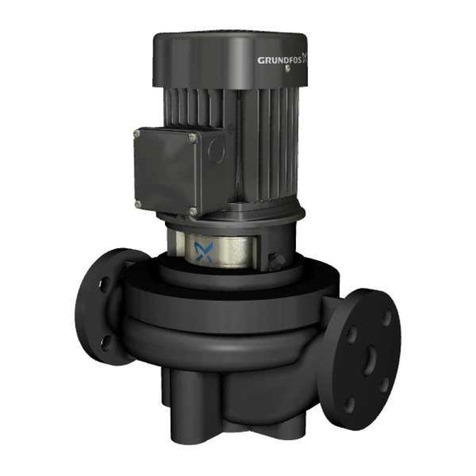
Grundfos
Grundfos TP 32-40 Product guide

EINHELL Expert
EINHELL Expert GE-WW 9041 E Original operating instructions
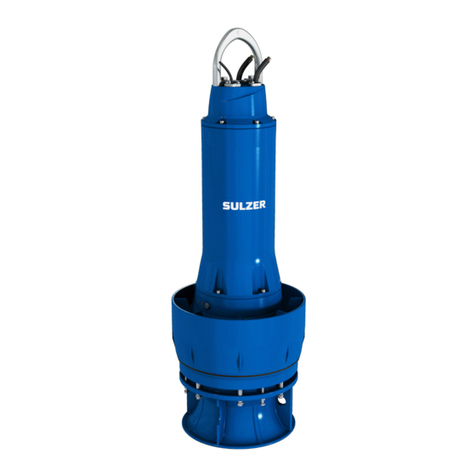
Sulzer
Sulzer ABS XFP-PE7 Series Installation and operating instructions

Steinberg
Steinberg PPG 280 S operating instructions

Remco
Remco 55AQUAJET-AES Operation and installation guide
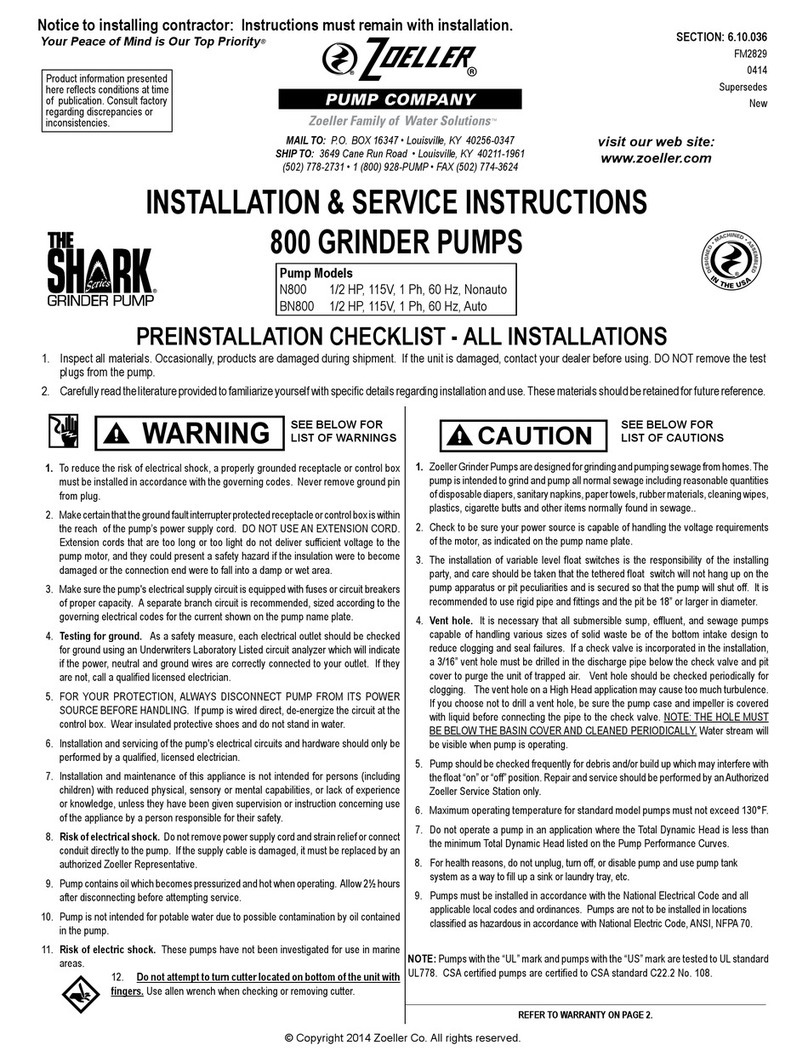
Zoeller
Zoeller SHARK Series Installation & service instructions
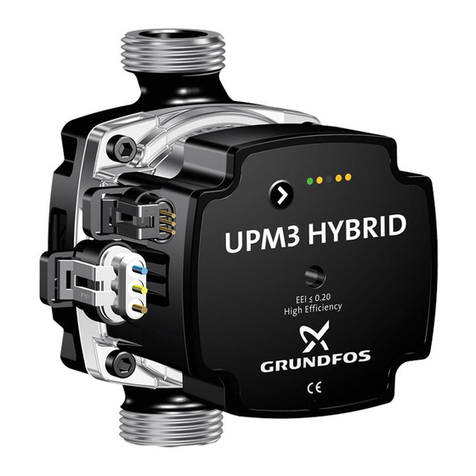
Grundfos
Grundfos UPM3 instruction manual
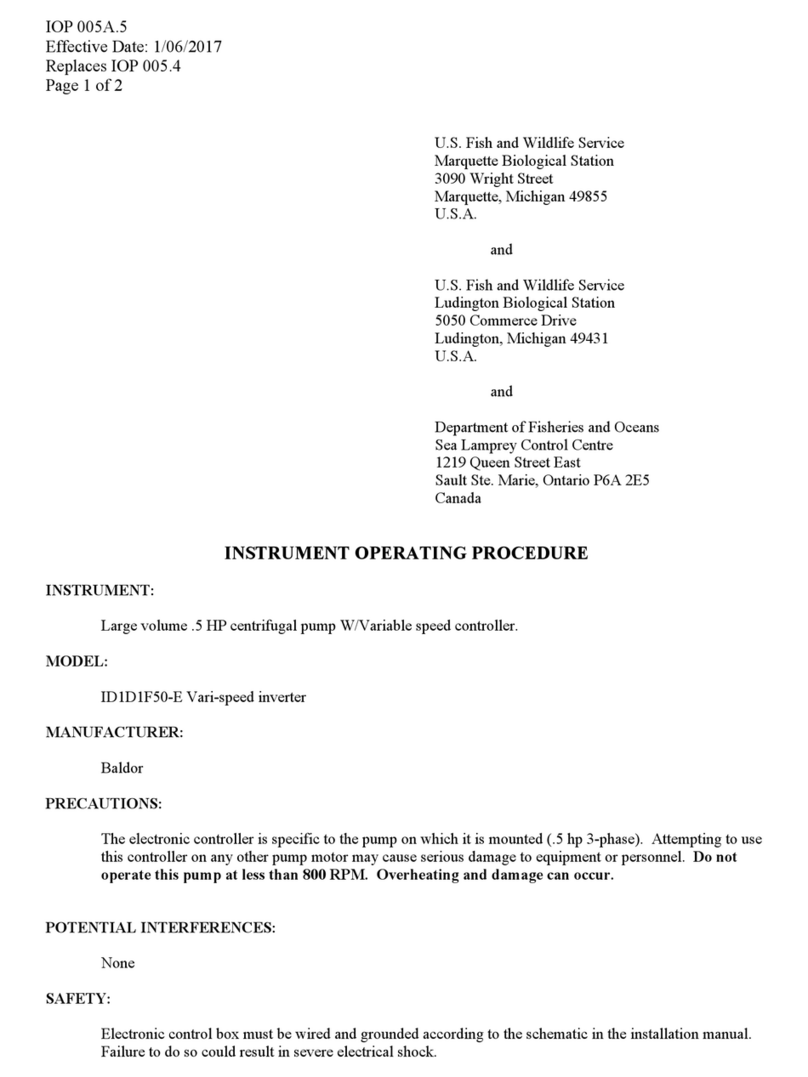
WILDLIFE
WILDLIFE ID1D1F50-E quick start guide
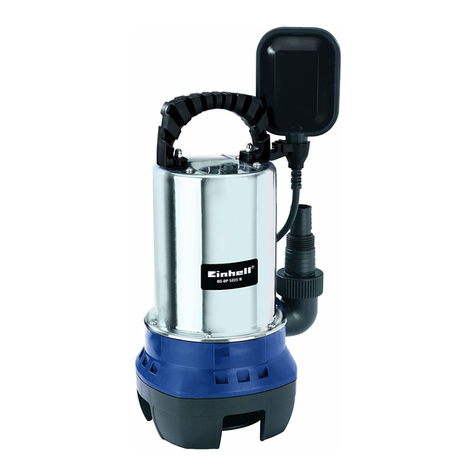
EINHELL
EINHELL BG-DP 5225 N Original operating instructions
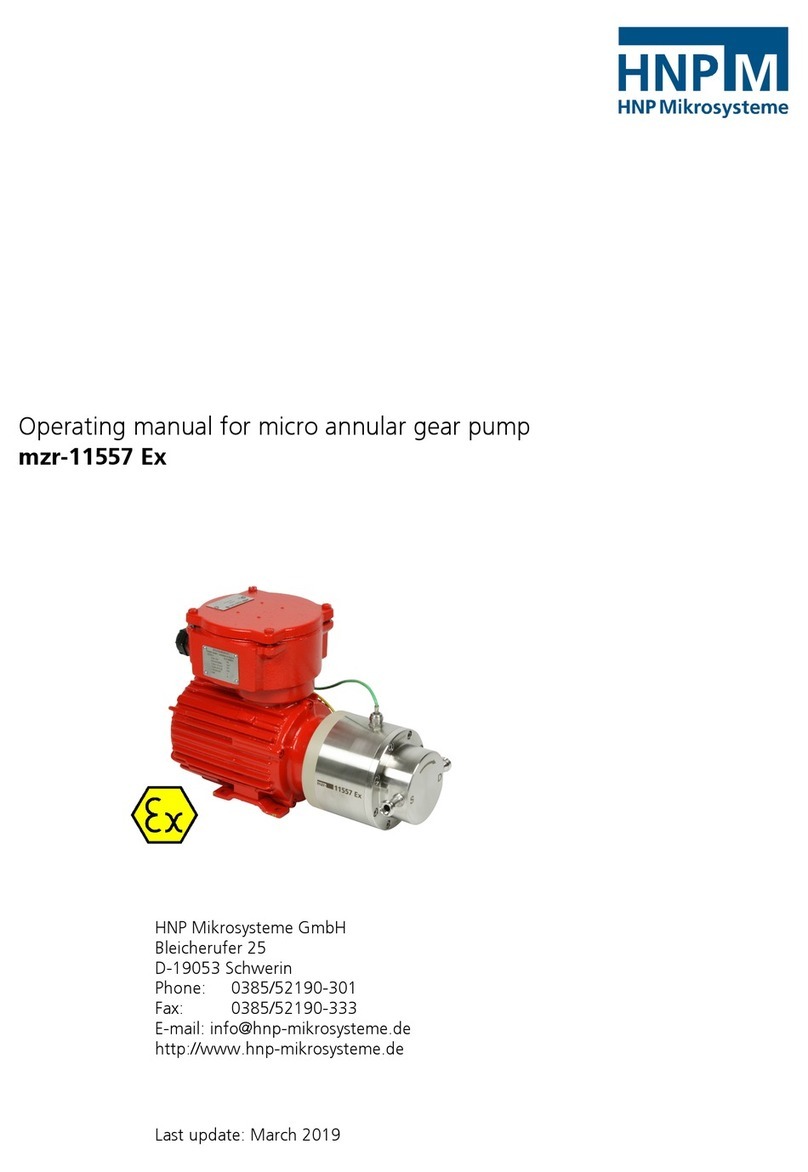
HNP Mikrosysteme
HNP Mikrosysteme mzr-11557 Ex Series operating manual
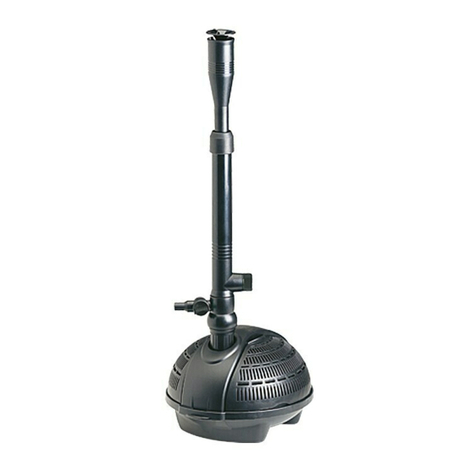
Neptun Premium
Neptun Premium NPTP-O 1500 operating instructions
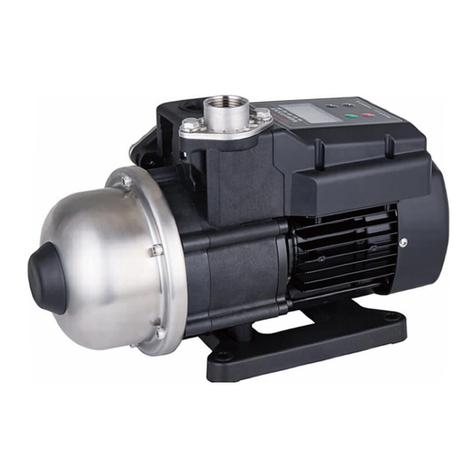
Profi-pumpe
Profi-pumpe INVERT-TECH2 operating instructions





